Cloud iridescence
Cloud iridescence or irisation is a colorful optical phenomenon that occurs in a cloud and appears in the general proximity of the Sun or Moon. The colors resemble those seen in soap bubbles and oil on a water surface. It is a type of photometeor. This fairly common phenomenon is most often observed in altocumulus,[1] cirrocumulus, lenticular,[2] and cirrus clouds.[3][4][5] They sometimes appear as bands parallel to the edge of the clouds. Iridescence is also seen in the much rarer polar stratospheric clouds, also called nacreous clouds.[6]
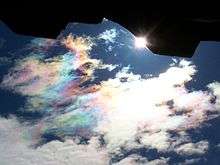

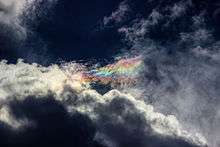
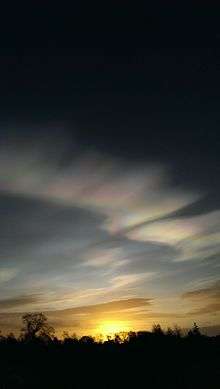
The colors are usually pastel, but can be very vivid or mingled together, sometimes similar to mother-of-pearl.[7] When appearing near the Sun, the effect can be difficult to spot as it is drowned in the Sun's glare. This may be overcome by shielding the sunlight with one's hand or hiding it behind a tree or building. Other aids are dark glasses, or observing the sky reflected in a convex mirror or in a pool of water.
Etymology
Irisations are named after the Greek goddess Iris, goddess of rainbows and messenger of Zeus and Hera to the mortals below.[8]
Mechanism
Iridescent clouds are a diffraction phenomenon caused by small water droplets or small ice crystals individually scattering light. Larger ice crystals do not produce iridescence, but can cause halos, a different phenomenon.
Irisation is caused by very uniform water droplets diffracting light (within 10 degrees from the Sun) and by first order interference effects[9] (Beyond about 10 degrees from the Sun). It can extend up to 40 degrees from the Sun.[10]
If parts of clouds contain small water droplets or ice crystals of similar size, their cumulative effect is seen as colors. The cloud must be optically thin, so that most rays encounter only a single droplet. Iridescence is therefore mostly seen at cloud edges or in semi-transparent clouds, while newly forming clouds produce the brightest and most colorful iridescence. When the particles in a thin cloud are very similar in size over a large extent, the iridescence takes on the structured form of a corona, a bright circular disk around the Sun or Moon surrounded by one or more colored rings.[11][12]
Gallery
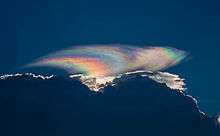
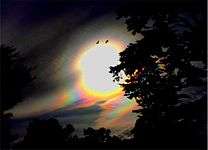



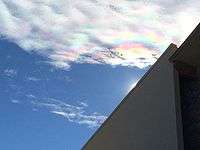
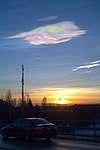
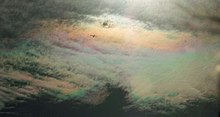 Irisation in clouds over Wellington NZ
Irisation in clouds over Wellington NZ Irisation or iridescence in super-cooled cloud droplets in cirrocumulus clouds.
Irisation or iridescence in super-cooled cloud droplets in cirrocumulus clouds. Irisation in cirrus (or maybe cirrocumulus) clouds behind Stratocumulus (bottom), in the afternoon over Warsaw, Poland.
Irisation in cirrus (or maybe cirrocumulus) clouds behind Stratocumulus (bottom), in the afternoon over Warsaw, Poland. Vibrant cloud iridescence captured before sunset
Vibrant cloud iridescence captured before sunset
References
- Gedzelman, Stanley David (1 June 1988). "In Praise of Altocumulus". Weatherwise. 41 (3): 143–49. doi:10.1080/00431672.1988.9930533.
- Answers.com - Sci-Tech Dictionary:irisation
- Nemiroff, R.; Bonnell, J., eds. (25 November 2007). "An Iridescent Cloud Over Colorado". Astronomy Picture of the Day. NASA.
- "Iridescent Clouds". Atmospheric Optics.
- Sassen, Kenneth (1 January 2003). "Cirrus cloud iridescence: a rare case study". Applied Optics. 42 (3): 486. Bibcode:2003ApOpt..42..486S. doi:10.1364/AO.42.000486.
- "Nacreous Clouds". Atmospheric Optics.
- PHOTOMETEORS, by Jesús Martínez-Frías Archived 2009-12-13 at the Wayback Machine
- The Cloudspotter's Guide By Gavin Pretor-Pinney, Page 233
- Color and Light in Nature By David K. Lynch, William Charles Livingston, Page 133
- PHOTOMETEORS, by Jesús Martínez-Frías Archived 2009-12-13 at the Wayback Machine
- "Corona". Atmospheric Optics.
- Shaw, Joseph A.; Pust, Nathan (12 August 2011). "Icy wave-cloud lunar corona and cirrus iridescence". Applied Optics. 50 (28): F6. Bibcode:2011ApOpt..50F...6S. doi:10.1364/AO.50.0000F6.
External links
| Wikimedia Commons has media related to Iridescent clouds. |
| Look up iridescent cloud in Wiktionary, the free dictionary. |
- Iridescent cloud gallery - Atmospheric Optics site
- On the Cause of Iridescence in Clouds - Scientific American Supplement